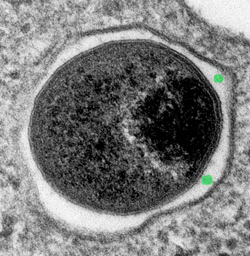contact
Shereece Singleton
Office Manager
F 410-706-0865
[Obligate intracellular parasitism]2: the biology of chlamydiaphages
 A major focus has been the study of phiCPG1, a bacteriophage co-discovered by Dr. Ru-ching Hsia, Director of the University Core Imaging Facility. PhiCPG1 infects a Chlamydia caviae strain (GPIC) infectious to guinea pigs (1), and is distantly related to the coliphage phiX174. PhiCPG1 causes developmental arrest in replicating chlamydiae and induces their lysis and that of the chlamydial inclusion (2). A significant finding through genomic analysis of Chlamydia pneumoniae strain AR39 was the isolation of the genome of a bacteriophage closely related to phiCPG1 (phiAR39). Fragments of the phage genome are also found integrated in the genomes of C. caviae, C. pneumoniae and other Chlamydia species. These findings have brought renewed momentum to investigations of the impact of phage infection on chlamydial infection and disease. A collaboration with Dr. Roger Rank, University of Arkansas for Medical Sciences, has led to the determination that phage infection of C. caviae significantly reduces ocular pathology in the C. caviae-infected guinea pig (3). Moreover, the existence of chlamydiaphages represents a unique opportunity for the development of phage-based genetics in Chlamydia, a current area of research in the laboratory.
A major focus has been the study of phiCPG1, a bacteriophage co-discovered by Dr. Ru-ching Hsia, Director of the University Core Imaging Facility. PhiCPG1 infects a Chlamydia caviae strain (GPIC) infectious to guinea pigs (1), and is distantly related to the coliphage phiX174. PhiCPG1 causes developmental arrest in replicating chlamydiae and induces their lysis and that of the chlamydial inclusion (2). A significant finding through genomic analysis of Chlamydia pneumoniae strain AR39 was the isolation of the genome of a bacteriophage closely related to phiCPG1 (phiAR39). Fragments of the phage genome are also found integrated in the genomes of C. caviae, C. pneumoniae and other Chlamydia species. These findings have brought renewed momentum to investigations of the impact of phage infection on chlamydial infection and disease. A collaboration with Dr. Roger Rank, University of Arkansas for Medical Sciences, has led to the determination that phage infection of C. caviae significantly reduces ocular pathology in the C. caviae-infected guinea pig (3). Moreover, the existence of chlamydiaphages represents a unique opportunity for the development of phage-based genetics in Chlamydia, a current area of research in the laboratory.
References
(1) Hsia, R.-c., Ting, L.-M., and Bavoil, P. M. (2000). Microvirus of Chlamydia psittaci strain GPIC: isolation and molecular characterization. Microbiol 146, 1651-1660.
(2) Hsia, R.-c., H. Ohayon, P. Gounon, A. Dautry-Varsat, & P.M. Bavoil. 2000. Phage infection of the obligate intracellular bacterium, Chlamydia psittaci strain GPIC. Micr. & Infect. 2:761-772. (3) Rank, R.G., A.K. Bowlin, S. Cané, H. Shou, Z. Liu, U. Nagarajan & P.M. Bavoil. 2009. Effect of chlamydiaphage phiCPG1 on the course of conjunctival infection of guinea pigs with Chlamydia caviae, Infect. Immun. 77:1216-1221.
